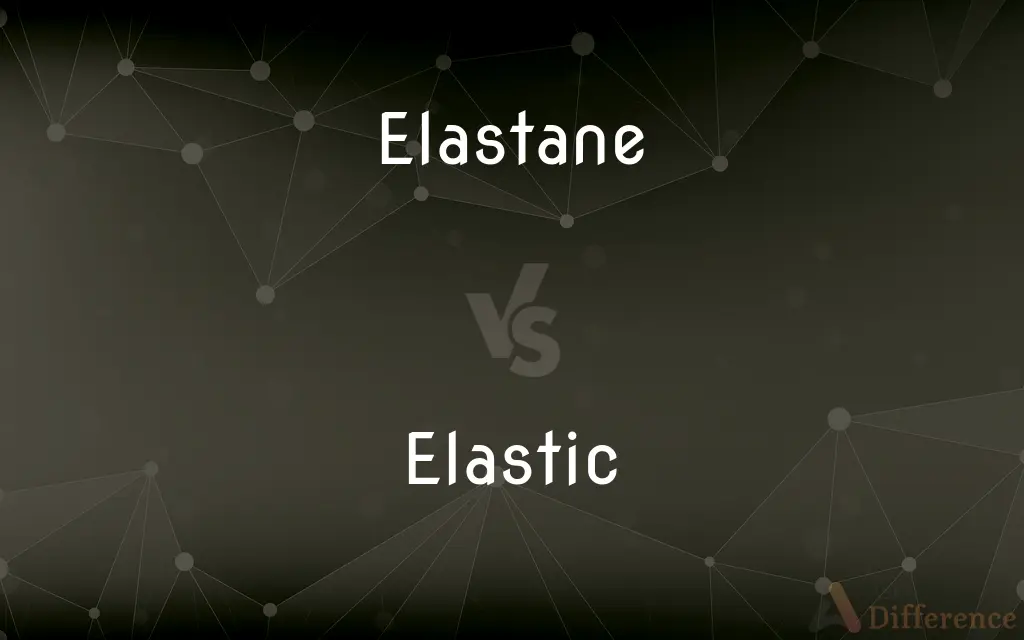Elastane vs. Elastic — What's the Difference?
By Fiza Rafique & Maham Liaqat — Updated on April 23, 2024
Elastane is a synthetic fiber known for its exceptional elasticity, used in textiles; elastic generally refers to a stretchable material or fabric, often containing elastane.

Difference Between Elastane and Elastic
Table of Contents
ADVERTISEMENT
Key Differences
Elastane, also known as spandex or Lycra, is a specific type of synthetic fiber renowned for its ability to stretch up to five times its original length and return to its original shape. In contrast, elastic is a broader category that includes any material, such as bands or fabrics, that is designed to be stretchable, which can include natural rubber or a mix of various fibers including elastane.
In terms of usage, elastane is primarily integrated into fabrics to provide stretch and shape retention in clothing such as sportswear, underwear, and hosiery. On the other hand, elastic materials are used more broadly in a variety of applications, from clothing waistbands and hair ties to medical bandages, where flexibility and tight fit are necessary.
From a composition standpoint, elastane is made from polyurethane, making it durable, lightweight, and resistant to lotions and perspiration. Whereas, elastic materials may be made from a variety of substances, including rubber or a blend of cotton and synthetic fibers, tailored to specific uses and varying in stretchability and durability.
The production of elastane involves a complex chemical process known as dry spinning, which requires sophisticated technology and facilities. Meanwhile, elastic materials can be produced through simpler processes depending on the composition, such as braiding, weaving, or knitting different fibers together.
On the market, products containing elastane are often labeled specifically due to its desirable properties in apparel, highlighting the brand names like Lycra. In contrast, products utilizing generic elastic materials may not specify the fibers unless it is a selling point, focusing instead on the functionality of the elastic.
ADVERTISEMENT
Comparison Chart
Composition
Made from polyurethane
Can be made from rubber, cotton, synthetic fibers
Stretchability
Extremely high, up to 500%
Varies, generally less than elastane
Applications
Sportswear, swimwear, underwear
Waistbands, hair ties, bandages
Production Process
Chemical process involving dry spinning
Weaving, knitting, braiding
Market Specification
Often labeled as Lycra or spandex
Rarely specified unless critical to product
Compare with Definitions
Elastane
Highly resistant to lotions and body oils.
Elastane is favored for use in sportswear due to its durability.
Elastic
Differing levels of stretchability and recovery.
Elastic materials are selected based on the required flexibility.
Elastane
Predominantly used in stretchable apparel.
Elastane provides comfort and flexibility in yoga pants.
Elastic
Used in various functional products.
Elastic bands are crucial in medical wraps and supports.
Elastane
A synthetic fiber with high elasticity.
Elastane is essential in swimwear for its ability to stretch.
Elastic
Can include a variety of fibers.
Elastic in socks often includes both cotton and synthetic fibers for comfort.
Elastane
Known for excellent shape retention.
Garments with elastane regain their shape even after rigorous use.
Elastic
Often less specified in product descriptions.
The elastic used in hair ties is typically not detailed on packaging.
Elastane
Commonly branded as Lycra or spandex.
Lycra, a type of elastane, is popular in high-performance fabrics.
Elastic
A material or fabric that stretches.
Elastic waistbands provide a snug fit in clothing.
Elastane
An elastic polyurethane material, used for hosiery, underwear, and other close-fitting clothing.
Elastic
Easily resuming original size or shape after being stretched or otherwise deformed; flexible.
Elastane
Spandex, lycra.
Elastic
Relating to a collision in which the total kinetic energy is conserved.
Elastic
Quick to recover, as from disappointment; resilient
An elastic spirit.
Elastic
Capable of being adapted to change or a variety of circumstances
"To say that morale is a highly unscientific and quite elastic concept would be an understatement" (Roger J. Spiller).
Elastic
(Economics) Of, relating to, or being a good for which changes in price have a large effect on the quantity demanded or supplied.
Elastic
A flexible stretchable fabric made with interwoven strands of rubber or an imitative synthetic fiber.
Elastic
An object made of this fabric.
Elastic
A rubber band.
Elastic
Capable of stretching; particularly, capable of stretching so as to return to an original shape or size when force is released.
The rope is somewhat elastic, so expect it to give when you pull on it.
Elastic
Made of elastic.
Elastic band
Elastic
Of clothing, elasticated.
Elastic
(economics) Sensitive to changes in price.
Demand for entertainment is more elastic than demand for energy.
Elastic
Springy; bouncy; vivacious
Elastic
Pervasive, all-encompassing.
Elastic
Able to return quickly to a former state or condition, after being depressed or overtaxed; having power to recover easily from shocks and trials.
Elastic spirits; an elastic constitution
Elastic
(uncountable) An elastic material used in clothing, particularly in waistbands and cuffs.
Running shorts use elastic to eliminate the need for a belt
Elastic
(countable) An elastic band.
Elastic
Springing back; having a power or inherent property of returning to the form from which a substance is bent, drawn, pressed, or twisted; springy; having the power of rebounding; as, a bow is elastic; the air is elastic; India rubber is elastic.
Capable of being drawn out by force like a piece of elastic gum, and by its own elasticity returning, when the force is removed, to its former position.
Elastic
Able to return quickly to a former state or condition, after being depressed or overtaxed; having power to recover easily from shocks and trials; as, elastic spirits; an elastic constitution.
Elastic
An elastic woven fabric, as a belt, braces or suspenders, etc., made in part of India rubber.
Elastic
A narrow band of elastic rubber used to hold things (such as papers) together
Elastic
An elastic fabric made of yarns containing an elastic material
Elastic
Capable of resuming original shape after stretching or compression; springy;
An elastic band
A youthful and elastic walk
Elastic
Able to adjust readily to different conditions;
An adaptable person
A flexible personality
An elastic clause in a contract
Common Curiosities
How are elastane and elastic different?
Elastane is a specific synthetic fiber, while elastic can be made from a variety of stretchable materials.
Where is elastane typically used?
Elastane is widely used in clothing that requires flexibility, such as sportswear and underwear.
What are common uses of elastic?
Elastic is used in many everyday items like hair ties, waistbands, and medical bandages.
Are there environmental concerns associated with elastane?
Yes, the production of synthetic fibers like elastane can have environmental impacts, including resource use and chemical waste.
Can elastic contain elastane?
Yes, elastic materials can include elastane among other fibers to enhance stretchability.
What defines elastic?
Elastic refers to any material that has a significant amount of stretch, often used in various forms of bands and fabrics.
What is elastane?
Elastane is a synthetic fiber known for high elasticity and resilience, commonly used in stretchable clothing.
How is elastane produced?
Elastane is produced through a chemical process known as dry spinning which involves turning a polymer into fibers.
Why is elastane often branded as Lycra?
Lycra is a brand name for elastane, marketed for its high-quality stretch and recovery properties.
Does the presence of elastane affect fabric care?
Yes, fabrics containing elastane may require special care, such as cold washing and air drying to maintain elasticity.
How is elastic incorporated into products?
Elastic is often woven, knitted, or braided into products depending on the desired elasticity and product design.
Is elastane more durable than other elastic materials?
Yes, elastane is highly durable, resistant to chemicals and perspiration, making it ideal for active wear.
What are the advantages of using elastane in sports apparel?
Elastane allows for greater movement and comfort, essential in sports apparel for performance and flexibility.
Can elastic be recycled?
Recycling of elastic materials depends on their composition, with some fibers being easier to recycle than others.
Is elastane better than traditional elastic for all applications?
Not necessarily; the choice between elastane and other elastic materials depends on the specific needs of the application, such as stretchability, durability, and cost.
Share Your Discovery

Previous Comparison
Benevolent vs. Benefactor
Next Comparison
Grandmother vs. MotherAuthor Spotlight
Written by
Fiza RafiqueFiza Rafique is a skilled content writer at AskDifference.com, where she meticulously refines and enhances written pieces. Drawing from her vast editorial expertise, Fiza ensures clarity, accuracy, and precision in every article. Passionate about language, she continually seeks to elevate the quality of content for readers worldwide.
Co-written by
Maham Liaqat















































